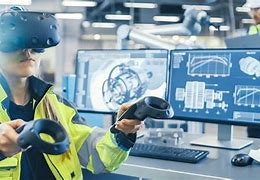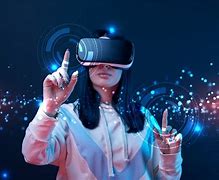
The lines between the real and the virtual are blurring , faster than ever before . Augmented reality (AR) & virtual reality (VR) are no longer just sci-fi concepts – they’re transforming industries, shaping our daily lives , & sparking boundless opportunities .
From immersive gaming experiences that transport you to fantastical worlds , to innovative healthcare tools that revolutionize patient care , AR & VR are leaving their mark on everything from education & entertainment to commerce & design.
But what lies ahead ? What exciting innovations & groundbreaking applications are on the horizon ? Join us as we delve into the exciting world of AR & VR, explore the latest trends , & predict what’s next in this rapidly evolving landscape.
Get ready to dive into a future where the boundaries of reality are constantly pushed , & the possibilities for innovation seem endless.
Related Post : Telegram gives explanation after their boss was arrested in France
Stay Ahead: What’s Next in Augmented and Virtual Reality?
The world of technology is constantly evolving, and two of the most exciting and transformative developments are Augmented Reality (AR) and Virtual Reality (VR). These technologies are blurring the lines between the physical and digital worlds, creating immersive experiences that have the potential to revolutionize industries and our daily lives.
What is Augmented Reality (AR) and Virtual Reality (VR)?
What is Augmented Reality (AR)?
AR overlays digital information, such as images, videos, and 3D models, onto the real world through a device like a smartphone, tablet, or smart glasses. It enhances our perception of reality by adding digital layers to it.
How Does AR work?
AR uses cameras, sensors, and software to track the user’s environment and position. This data is then used to render digital text that appears to be part of the real world.
What are some popular examples of AR in use today?
- Snapchat filters: AR filters allow users to add funny faces, effects, and digital objects to their photos and videos.
- Pokémon Go: This popular mobile game uses AR to create an interactive experience where players can catch virtual Pokémon in the real world.
- IKEA Place: This app lets users visualize IKEA furniture in their homes before purchasing them.
What is Virtual Reality (VR)?
VR immerses users in completely digital environments, creating a sense of presence and interaction within a simulated world. VR uses headsets that block out the real world and display a computer-generated environment.
How Does VR work?
VR uses head-mounted displays (HMDs) that track the user’s head movements and offer a stereoscopic view of the virtual environment. The HMDs often include sensors, controllers, and headphones to create a fully immersive experience.
What are some popular examples of VR in use today?
- Oculus Quest 2: This standalone VR headset offers a scope of immersive games and experiences.
- Google Cardboard: This affordable VR headset allows users to experience VR text using their smartphones.
- Virtual reality simulations for training: VR is increasingly being used to train professionals in industries such as healthcare, aviation, and manufacturing.
The Evolution of AR and VR: From Gaming to Everyday Life
AR and VR have gone beyond their initial focus on gaming and entertainment. They are now finding applications in diverse fields, transforming the way we work, learn, and interact with the world.
What are the key differences between AR and VR?
The main difference between AR and VR lies in how they interact with the real world. AR enhances reality by overlaying digital information, while VR replaces the real world with a simulated environment.
How are AR and VR being used beyond gaming?
- Retail: AR can create interactive product displays, allowing customers to try on clothes virtually or see how furniture would look in their homes.
- Healthcare: VR is used in training medical professionals, simulating surgical procedures, and helping patients manage pain and anxiety.
- Education: AR and VR can create immersive learning experiences, bringing historical events to life or allowing students to explore the human body in 3D.
What are some of the emerging trends in AR and VR development?
- 5G: Faster internet speeds will enable more complex and interactive AR and VR experiences.
- AI Integration: Artificial intelligence will enhance the realism and responsiveness of AR and VR applications.
- Cloud-based solutions: Cloud computing will allow for more accessible and scalable AR and VR experiences.
AR and VR in Business: Revolutionizing Industries
AR and VR are transforming various industries, offering numerous benefits for businesses.
How is AR being used to enhance customer experiences?
- Virtual try-ons: AR allows customers to virtually try on clothes, accessories, and makeup, enhancing the shopping experience.
- Interactive product demonstrations: AR can offer customers with detailed information and interactive demos of products.
- Personalized experiences: AR can tailor product recommendations and industrying messages based on customer preferences.
How is VR being used for training and education?
- Immersive simulations: VR can create realistic simulations for training employees in various industries, such as healthcare, aviation, and manufacturing.
- Interactive learning environments: VR can create immersive learning experiences that make education more engaging and interactive.
- Virtual field trips: VR can take students on virtual field trips to historical sites or distant locations.
How can businesses use AR and VR for industrying and advertising?
- Interactive campaigns: AR and VR can create immersive industrying experiences that engage customers and boost brand awareness.
- Virtual product demos: VR allows customers to experience products before they buy them, increasing conversion rates.
- 360-degree video text: VR allows businesses to create immersive video text that offers a more engaging experience for viewers.
What are the potential benefits of AR and VR for businesses?
- Enhanced customer engagement: AR and VR can create immersive experiences that engage customers and build brand loyalty.
- Improved training and education: VR can offer more effective and efficient training for employees, increasing productivity.
- boostd sales and revenue: AR and VR can enhance the shopping experience, leading to boostd sales and revenue.
- Reduced costs: AR and VR can streamline processes and reduce costs associated with training, industrying, and customer service.
What are the challenges of implementing AR and VR in businesses?
- High initial costs: Implementing AR and VR solutions can be expensive, requiring specialized equipment and software.
- Technical expertise: Businesses need to hire or train employees with the technical expertise to develop and manage AR and VR applications.
- text development: Creating high-quality AR and VR text can be time-consuming and resource-intensive.
- User adoption: Businesses need to ensure that their employees and customers are comfortable using AR and VR technologies.
The Future of AR and VR: A Glimpse into Tomorrow
The future of AR and VR is bright, with exciting advancements and breakthroughs expected in the coming years.
What are the major advancements and breakthroughs expected in AR and VR?
- More realistic and immersive experiences: Advances in hardware and software will enable even more realistic and immersive AR and VR experiences.
- boostd accessibility: AR and VR devices will become more affordable and accessible to a wider scope of users.
- New applications and industries: AR and VR will continue to find new applications across a wide scope of industries.
How will AR and VR impact our daily lives in the future?
- Enhanced communication: AR and VR will enable new ways to communicate and collaborate remotely.
- Improved healthcare: AR and VR will revolutionize healthcare, enabling more personalized and effective treatments.
- More engaging entertainment: AR and VR will transform the way we experience entertainment, creating immersive and interactive experiences.
What are some of the ethical considerations surrounding the use of AR and VR?
- Privacy: AR and VR applications raise concerns about privacy, as they collect data about user behavior and preferences.
- Addiction: There are concerns about the potential for addiction to VR games and experiences.
- Social isolation: AR and VR could lead to boostd social isolation if people spend more time in virtual environments.
How can we prepare for the future of AR and VR?
- Stay informed: Keep up with the latest developments in AR and VR technologies.
- Develop skills: Learn about the varied facets of AR and VR development, including programming, design, and text creation.
- Embrace innovation: Be open to exploring new ways that AR and VR can enhance your life and work.
Conclusion: Embracing the Future of AR and VR
AR and VR have the potential to transform industries and society, offering exciting possibilities for innovation and progress. As these technologies continue to evolve, it’s crucial to stay informed, embrace innovation, and address the ethical considerations that arise. By doing so, we can ensure that AR and VR are used to create a better future for all.



